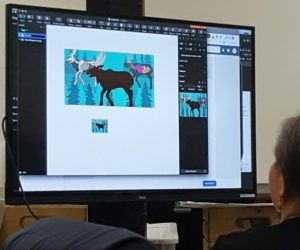Wiikwemkoong ogoki learning apps go live

By Rick Garrick
WIIKWEMKOONG UNCEDED TERRITORY — Wiikwemkoong Anishinaabemowin Kinoomaagewin highlighted its Moose 101 Anishinaabemowin language app featuring the different parts of a moose during PD Day sessions in Wiikwemkoong on Oct. 25.
“Lots of people downloaded it that day,” says Kelsey Dowdall, graphic designer with Wiikwemkoong Anishinaabemowin Kinoomaagewin. “The main thing for that app that we released was just more informational because they’re doing a lot of land-based learning, and the Moose 101 is about what all the pieces of the moose are used for so that we don’t waste anything.”
Dowdall says the next update of the app will include the audio for the Anishinaabemowin words for the different moose parts.
“Right now, it is just the spelling and the translations,” Dowdall says.
Sandra Peltier, lead program teacher with Wiikwemkoong Anishinaabemowin Kinoomaagewin, says the school staff were “very excited” about the Moose 101 Anishinaabemowin language app during the PD Day sessions.
“The reason why we wanted the app was because most of our educators don’t speak the language,” Peltier says. “I have tested them [and] they know quite a bit, but the thing they are not confident with is to speak the words that they know for fear of mispronouncing, being discouraged or being told they are not saying it right.”
Dowdall and Darlene Peltier, illustrator with Wiikwemkoong Anishinaabemowin Kinoomaagewin, learned how to create the Moose 101 Anishinaabemowin language app during a week-long training session in early October with Ogoki Learning Inc. president and CEO Darrick Baxter and another Ogoki Learning staff member.
“It was fun,” Darlene says. “Darrick was a really nice person and he showed us step-by-step how to work the app. At first, it was really hard for me but I kind of got used to it.”
Sandra Peltier says the next phase is to create a proposal to combine language and land-based connections.
“The biggest part for us is to make sure we have a lot of interviews with Elders, people visiting one another in the language so people can hear the different parts of how you speak a language when they are communicating amongst each other,” Peltier says. “We have all the print resources [including] pictures, but we don’t have the resources for people to hear so they can hear actual conversations between people.”
Peltier says about 20 per cent of the citizens in Wiikwemkoong currently speak Anishinaabemowin.
“So we want to ensure we have all the language on tape,” Peltier says. “And then get all of the audio into our department so people that are learning will be able to hear people and they can try to speak as much as they can and gain confidence that way.”
Peltier adds that the community needs to bring their language back.
“In 2004, my kids developed a Pictionary, and one of the things one of the students brought out was the importance of language,” Peltier says. “If we don’t learn it, then we will be like any civilian walking the streets.”
Peltier says the language apps will be used by students in all four of Wiikwemkoong’s schools, from JK to Grade 12.
“With our JK-SK, they remain with the teacher for two years so we can maximize their learning of Anishinaabemowin,” Peltier says.
Ogoki Learning Inc., based in Winnipeg with a recently opened office in Taiwan, has helped create more than 170 language apps and interactive learning tools for schools and First Nations across Canada and the United States.

